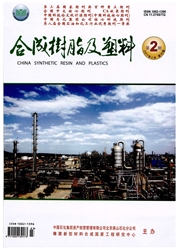

 中文摘要:
中文摘要:
研究了退火处理后光学级聚碳酸酯(PC)的冲击断面形貌,重点分析了周期条纹和带状形貌的形成机理。经退火处理的PC冲击断面形貌主要由断裂源区、雾区和末端带状区组成。基于断面形貌分析,认为雾区内周期条纹的形成是应力波改变了银纹及其附近基体的应力场,从而导致裂纹路径发生改变的结果。周期条纹中银纹带和无特征区宽度的变化则是裂纹扩展时所在银纹层厚度减小的结果。末端带状区内带状形貌的形成机理是一个裂纹扩展的间歇过程,即“黏一滑”过程。
 英文摘要:
英文摘要:
The authors studied the morphology of impact fracture surface of annealed optical-grade poly- carbonate (PC), with an emphasis on the formation mechanism of cycle stripes and band morphology. The mor- phology of impact fracture surface of annealed PC could be divided into fracture original region, mist region and end-wall band region. Based on the analysis of the fracture surface morphology, it is considered that the forma- tion of cycle stripes in the mist region is the result that the stress fields of the craze and matrix near the craze are changed by stress waves, leading to the change of crack paths. The decrease of the thickness of the craze layer during crack propagation results in the change of the craze band and the nondescript region' s width in cycle stripes. The formation mechanism of the band morphology in the end-wall band region is a batch process of crack propagation, i.e. a stick-slip "process.
 同期刊论文项目
同期刊论文项目
 同项目期刊论文
同项目期刊论文
 Effects of modified silica on morphology, mechanical property, and thermostability of injection-mold
Effects of modified silica on morphology, mechanical property, and thermostability of injection-mold Realizing the simultaneously improved toughness and strength of ultra-thin LLDPE parts through annea
Realizing the simultaneously improved toughness and strength of ultra-thin LLDPE parts through annea Fracture toughness assessment of polypropylene random copolymer with multiple stress modes using the
Fracture toughness assessment of polypropylene random copolymer with multiple stress modes using the Synergies among the self-assembled beta-nucleating agent and the sheared isotactic polypropylene mat
Synergies among the self-assembled beta-nucleating agent and the sheared isotactic polypropylene mat Enhanced mechanical properties of polyethylene composites with low content of electrospun nylon-66 n
Enhanced mechanical properties of polyethylene composites with low content of electrospun nylon-66 n A facile strategy for functionalizing silica nanoparticles by polycarbonate degradation and its appl
A facile strategy for functionalizing silica nanoparticles by polycarbonate degradation and its appl A comparison between strain sensing behaviors of carbon black/polypropylene and carbon nanotubes/pol
A comparison between strain sensing behaviors of carbon black/polypropylene and carbon nanotubes/pol 期刊信息
期刊信息
